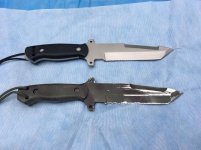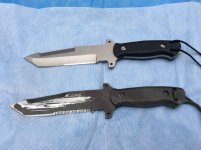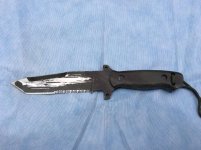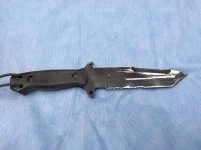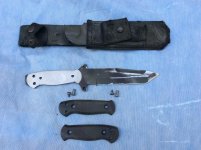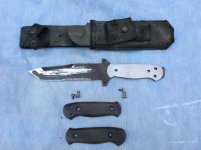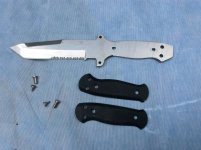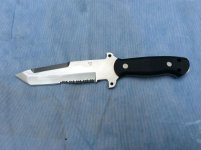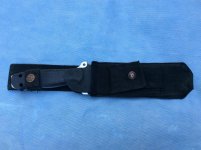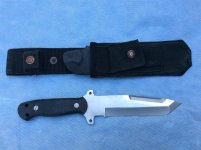abbyonheyward
Member
Gents,
Greetings from South Carolina.
I purchased a Buck 189 tanto (a.k.a Buck Intrepid) several years back. It's the one in the photos with the bead blast finish and black scales. This knife was discontinued by Buck +/ - 15 years ago. I've enjoyed owning it, so much so that I have been monitoring auction sites for others like it, and the similar, but slightly smaller, Buck 187. Several days ago I won an auction for another used Buck 189. It was cheap compared to the others I've run across in the past 10-15 years. Cheap because a previous owner spray painted the whole thing dark green and brown - including the scales and the sheath. It's the ugly duckling in the photos. Underneath the paint, the knife itself is in good condition, undoubtedly functional, and it has a decent edge on it.
Does anyone have recommendations on how to remove the spray paint from the blade without damaging the steel - and the polymer scales and scale screws?
In the many years that I have been a member of this forum, I have come to appreciate the vast and diverse experience and knowledge of other members - about firearms and lots of other things, too. All kinds of people from all walks of life. There's a lot of knowledge here that I am trying to tap into.
I have my own ideas about how to remove the paint, but any guidance / advice from those of you who may have experienced similar situations would be much appreciated.
I am considering:
1. Bead blasting or other media blasting, because it will 1) get rid of the paint and 2) I may want a bead blast finish on the metal. Doubtful that the textured polymer scales will hold up to that. Problematic because I don't have the equipment to do it myself.
2. Chemical strip. Again worried about screwing up the scales.
3. Manual removal. Wire brush, etc. - my least likely option for fairly obvious reasons - primarily damaging the metal and scale material.
4. Possible combinations of the options above.
Instead of potentially damaging the scales while trying to remove the paint, I am considering spraying a few coats of black paint on top of the existing green / brown. Under the paint, the scales are nicely textured and in overall good condition. Not inclined to leave the scales as they are currently.
With regards to the final finish, and once the paint is removed from the steel, I am considering bead blasting, polishing, or a scotch brite pad finish.
My goal is not to restore the knife to as new condition, but to make it more presentable, increase the value, and maintain its functionality.
Lastly, I don't want to invest more money into this "project" than the end result will be worth.
What say you?
Thanks,
Ryon
Greetings from South Carolina.
I purchased a Buck 189 tanto (a.k.a Buck Intrepid) several years back. It's the one in the photos with the bead blast finish and black scales. This knife was discontinued by Buck +/ - 15 years ago. I've enjoyed owning it, so much so that I have been monitoring auction sites for others like it, and the similar, but slightly smaller, Buck 187. Several days ago I won an auction for another used Buck 189. It was cheap compared to the others I've run across in the past 10-15 years. Cheap because a previous owner spray painted the whole thing dark green and brown - including the scales and the sheath. It's the ugly duckling in the photos. Underneath the paint, the knife itself is in good condition, undoubtedly functional, and it has a decent edge on it.
Does anyone have recommendations on how to remove the spray paint from the blade without damaging the steel - and the polymer scales and scale screws?
In the many years that I have been a member of this forum, I have come to appreciate the vast and diverse experience and knowledge of other members - about firearms and lots of other things, too. All kinds of people from all walks of life. There's a lot of knowledge here that I am trying to tap into.
I have my own ideas about how to remove the paint, but any guidance / advice from those of you who may have experienced similar situations would be much appreciated.
I am considering:
1. Bead blasting or other media blasting, because it will 1) get rid of the paint and 2) I may want a bead blast finish on the metal. Doubtful that the textured polymer scales will hold up to that. Problematic because I don't have the equipment to do it myself.
2. Chemical strip. Again worried about screwing up the scales.
3. Manual removal. Wire brush, etc. - my least likely option for fairly obvious reasons - primarily damaging the metal and scale material.
4. Possible combinations of the options above.
Instead of potentially damaging the scales while trying to remove the paint, I am considering spraying a few coats of black paint on top of the existing green / brown. Under the paint, the scales are nicely textured and in overall good condition. Not inclined to leave the scales as they are currently.
With regards to the final finish, and once the paint is removed from the steel, I am considering bead blasting, polishing, or a scotch brite pad finish.
My goal is not to restore the knife to as new condition, but to make it more presentable, increase the value, and maintain its functionality.
Lastly, I don't want to invest more money into this "project" than the end result will be worth.
What say you?
Thanks,
Ryon
Attachments
Last edited:

